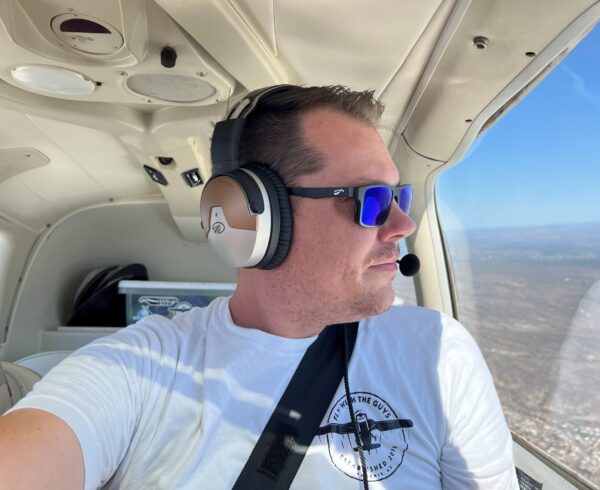Section 2: Acoustic Issues
Understanding and comparing cancellation specifications
Section 1 of this series dealt with the variables and complexity involved in canceling the repetitive and random aspects of airplane noise. It explained that although the basic elements of all active noise reduction systems are pretty much the same, the details of how they are designed and implemented has everything to do with the results you’ll experience.
The focus of this session is on the ways of measuring noise cancellation and determining comparative performance. Many claims are made about the amount of cancellation a given headset will provide. As we’ve said all along, the very best way to choose an ANR headset is to actually try out various headset models in the aircraft you usually fly. No chart, graph, or product review is as effective in determining your best choice of headsets as actually flying with them. Unfortunately, that is often not feasible, so you’re left to make a purchase decision based on the information you get from the manufacturers, the product reviews you read in the aviation press, and word-of-mouth recommendations from other pilots.
Our goal in this section, then, is to give you the knowledge you need to ask better questions and make a more critical analysis of the active and passive cancellation you can expect from a particular ANR headset model.
The cancellation profile
All active headsets have a profile of sound they are able to cancel. The profile can be graphed to chart the amount of cancellation and where in the noise frequency spectrum that cancellation occurs. The measurement process is relatively simple but requires fairly sophisticated laboratory equipment and techniques. The testing is done inside a closed, controlled acoustic chamber. The headset is mounted on a fixture that has a microphone located inside an artificial “ear” whose purpose is to sense or “hear” what you would hear. The headset is then swept with a tone from 10 hz to 10,000 hz…with the “ear” recording what was heard. The sweep is done twice, once with the ANR circuitry turned off and another with it turned on. The difference between the first and second sweeps indicates what was incrementally cancelled when the active system was engaged. The results are then usually plotted in the form of a graph, with frequency in Hertz (Hz) on the horizontal axis and cancellation in negative deciBels (dB) on the vertical axis:
Of course, different headsets provide different results based on how well they have managed the variables we learned about in Section 1 of this series. Before we begin to do any comparisons, let’s first talk about the attributes of this cancellation curve that will be present in every active headset. They include:
- Depth: how deep is the cancellation at its deepest point?
- Breadth: how wide is the cancellation frequency spectrum?
- Position: at what frequency the cancellation profile is centered?
- Boosting: places in the cancellation spectrum where ANR actually does more harm than good (i.e., noise is amplified rather than cancelled).
Each attribute tells us something about the effectiveness you can expect to hear from the cancellation.
Depth
The depth of the curve tells us the maximum amount of cancellation you would generally expect. Normally this is the active cancellation number that a manufacturer will advertise. Typically a range of 2-4 dB is given since variations in mic sensitivity, calibration, and even specific ergonomics of the pilot will have some modest effect on the final cancellation. It’s important to make sure you know how the cancellation measurements were made. Some manufacturers publish noise reduction figures that were not measured at the “ear” but at the headset’s ANR sensing mic instead. Recall from Section 1 of this series that the best ANR systems position the sensing mic to provide optimal correlation to the ear canal position, but correlation is never perfect. For example, headset “T” in the above graph claims 14-16 dB of cancellation but only measured about 11dB at the ear. Since every 3 dB represents roughly a doubling of sound pressure, that discrepancy is quite large and is probably explained by that different measurement technique.
Breadth

Position
You’ll notice in the graph that one headset cancels more low frequency than the other. While every plane has its own unique noise signature, it turns out there are some common things we can say about most single-engine piston planes:
- The loudest part of the noise spectrum is generated by the resonant frequency of the propeller. For direct-drive engines red-lined at 2400-2700 RPM, that will occur at 80-90 Hz for two-bladed props and 120-130 Hz for three-bladed ones. That is the specific point in the spectrum where the noise is loudest.
- The overall noise envelope in the cabin of these airplanes is loudest from about 40 Hz to 250 Hz, so this is the range where cancellation is most important. Noise levels at even 500 Hz are typically down at least 10dB from those at 100 Hz.
Section 3 of this series deals in depth with airplane noise spectrums and how they “overlay” with active and passive performance. For now, it’s sufficient to understand simply that the loudest noises are at the lower frequencies. So a cancellation profile “position” that is centered between 85 and 130 Hz will probably be the most effective in the typical piston-powered airplane.
Boosting
This is the last characteristic evident in all ANR cancellation profiles, and perhaps the least understood by most prospective purchasers of ANR headsets. Boosting is actually amplified, out-of-phase noise created by the ANR electronics that is not cancelled by existing ambient noise. Simply put, it represents the “overshoot” of the electronic “anti-noise” signal introduced into the acoustic chamber. It is present to some extent in virtually all active headsets, and here’s why. (Refer to the cancellation profile graph above to follow this).
The physics of sound waves and the acoustic cavity makes significant cancellation much more difficult as frequencies increase. This is due to the shorter wavelengths of sound at higher frequencies, in relation to the physical distance between the sensing microphone and the anti-noise speaker. The graph above shows this phenomenon on various headsets, all of which have declining cancellation at frequencies above 300 Hz. The deeper the 100 Hz cancellation, typically the steeper the profile drops off between 300 and 600 Hz. The steeper the drop-off, the harder it is to avoid some “overshoot” of uncancelled noise.
Is boosting a bad thing?
While not disastrous, we’d always like to have less. Like so many things, tradeoffs have to be made between the amount of boosting and the overall system cancellation. Unfortunately, greater overall cancellation generally means higher levels of boosting. This explains why the best canceling headsets often have the largest boosting effects. All things considered, the additional cancellation is generally worth it for at least two reasons:
- Typically the boosted dB levels are relatively low (3-6 dB) while the additional cancellation at low frequencies are much larger. The actual amount of boosted noise (shaded area under the curve) is quite small compared to the total noise cancelled.
- The boosting generally occurs at higher frequencies around 1 kHz where headsets typically have significant passive attenuation, and where most airplanes have relatively low noise to begin with. The net effect is still significant noise reduction at those higher frequencies…just a little less!
The one exception is low-frequency boosting like that shown for Headset “C” in the graph. While only 3-5 dB, the headset might provide less than 5 dB of protection passive at 40 Hz, so the additional noise introduced by the ANR circuitry could be more noticeable at those frequencies.
Congratulations! You now know more about interpreting cancellation profiles of ANR headsets than 99% of the pilot population (not to mention most so-called avionics experts). Of course, you can only use this data to compare the performance of different ANR headsets accurately if the data for the various headsets was derived using similar testing methods. Testing variables such as mic placement, sensitivity, and fixture design will substantially change the measured results. Again, the absolute best test data comes from your own ears…comparing different headsets in different planes and with different people!
“Total” Cancellation: an “apples and oranges” comparison
We can’t leave the subject of cancellation measurement and comparison without dealing with a very misleading notion: “Total” cancellation. What we’re talking about here is the practice of adding some measurements or claims of passive cancellation to the ANR cancellation profiles we discussed above. While often done in advertisements, this practice is inaccurate and quite misleading for several reasons. To understand why, you must first understand the “NRR” measurements that are normally used to quantify passive hearing protection systems, and how this relates to aircraft noise.
Passive attenuation (NRR) measurements
There is still considerable debate about how well this “standard” fits the aircraft environment. The NRR measurements were developed for industrial safety hearing applications where the noise spectrum is higher in frequency, and intermittent or impact based (e.g., the noise in a machine shop). The way the noise was measured affects the relative importance of the frequencies in the weighting of the noise effect on your hearing. The graph below shows the “equivalent effect” curves for different scales of noise.
Hearing protectors (including headsets) were measured and rated based on “A” weighted noise curve. As you can see, the ratings are heavily weighted to the 1 to 4 kHz noise spectrum for protection based on hearing protection needs of our ears. Because of the way God designed our ears, we can tolerate about 20 dB more 100 Hz noise without hearing damage than we can 1,000 Hz noise. (That’s why the “A” scale curve crosses the 100 Hz line at about -20 dB.) “A” weighted NRR measurements “discount” the 100 Hz noise by 20 dB in the calculations of hearing protection.
The problem for pilots is that we don’t fly machine shops, and our cockpits have lots of 100 Hz noise…often 25-30 dB more there than at 1,000 Hz!! While it’s true that we are more susceptible to hearing damage from higher frequencies, the dB levels we’re exposed to at low frequencies often contribute significantly to the hearing loss that pilots who fly without hearing protection often suffer. Those excessive levels of low-frequency noise also have a noticeable effect on speech intelligibility and human physiology…which we’ll cover more in Section 3 and Section 4 of this series. Consequently, “A” weighted NRR measurements are really not the best standard for judging the protection your headset will provide in your single engine airplane
Real NRR data for active headsets
Even if NRR could be used as a reference (by using a weighting more appropriate to the cockpit noise spectrum), there is a problem with using such figures for active headsets. We’re not aware of a single manufacturer who publishes actual NRR measurements for their active headset models
When passive headsets are “converted” by adding active noise reduction circuitry, sales literature often “implies” that the active cancellation is in addition to the headset’s original passive NRR. However, the fundamental laws of acoustics dictate that passive attenuation will go down when active circuitry is inserted and cavity space is consumed in the active version. Recent product reviews of ANR insert kits make this point quite clear.
The NRR and active cancellation “numbers” don’t add up!
Passive attenuation NRR is an accumulated measure of cancellation taken at eight frequencies from 125 Hz to 8,000 Hz. Those numbers typically range from about -10 dB to well over -30 dB…a very wide range! The NRR (which is a single figure) is intended to provide a summary measure of cancellation over a very broad spectrum of noise (weighted for hearing protection as discussed above). By contrast, the active cancellation dB numbers that are normally quoted refer to “peak” attenuation at one frequency where active noise cancellation is at a maximum. When you add the broad spectrum-weighted NRR to the single-frequency active cancellation figure, you get nonsense! The figures simply cannot be added with any validity.
So how can you judge which ANR headset is most effective?
If you’ve read this far, you already know the answer. Compare the active cancellation profiles of headsets, provided they were derived using comparable measurement techniques. Look for the depth, breadth, and position of the ANR spectrum. Look also for areas where boosting occurs, particularly at the low-frequency end of the spectrum, where it’s likely to be noticeable. Then once you’ve developed your “short list” of headset candidates, try to actually fly with them so you can truly evaluate the performance, comfort and convenience features of each one. After all, the ultimate laboratory test fixture is your own head in the cockpit of your own airplane!















